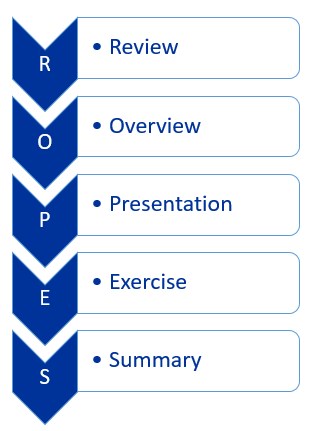ROPES Model
The ROPES Model is an effective instructional design strategy to increase learning outcomes. ROPES is an acronym for the steps in the instructional model. It stands for:
- Review
- Overview
- Presentation
- Exercise
- Summary
About the ROPES Model
The ROPES model is designed to have a facilitator sequentially teach a new topic or concept (knowledge, skill, or attitude) to learners. The content is delivered through a step-by-step process to help ensure learning will occur.
ROPES Model Overview
Review
The facilitator enquires into the learner’s background knowledge to create a transition from current knowledge to the topic or concept they plan to introduce.
- State main training goal
- Ask about learner’s experiences and familiarity with topic or concept
Overview
The facilitator provides an overview of the new topic or concept to inform the learners what to expect during the session.
- Provide a general overview
- State learning objectives
- Describe benefits of understanding topic or concept
- Highlight importance of content
Presentation
The facilitator presents the new topic or concept.
- Describe general concept
- Discuss steps involved
- Demonstrate steps
- Give examples
Exercise
Learners engage in activities that allow them to apply the new topic or concept.
- Facilitate activities
- Have learner explain how and why
- Observe and ask questions
Summary
The facilitator highlights the key points of the session to reinforce the learning that has occurred.
- Highlight key points
- Review learning objectives
- Ask and answer questions
ROPES Model Steps and Content
Review
The first step in the ROPES model is the review. This is when the facilitator enquires into the learners’ background knowledge of the topic to determine their experience level with the topic.
The purpose of this first step is to create a transition for the learner by relating the current topic to the learner’s experience. This allows the learner to begin to think how the topic will be integrated into something they already know. It also helps the learner piece everything together and see how the new information fits into what they currently know. If the facilitator jumps into teaching them a topic and does not relate it to what they know, it may take some time before the learner understands how all the information fits together.
Steps:
- Introduce the topic
- State the main training goal
- Ask about learner’s familiarity and experiences with topic
- Encourage the learner to share his or her knowledge or past experience with the topic
Overview
The second step in the ROPES model is the overview. This is when the facilitator presents the learning objectives and the main parts of the session. This should also include the benefits and importance to the learner of learning the topic so that they are motivated to learn.
The purpose of this step is to provide the learners with a mental picture of what is to come and begin to engage them so that they are motivate to learn.
Steps:
- Provide an overview of the activities that will occur in the session
- Highlight importance of topics
- Discuss learning objectives
- Establish why it is important to learn the topic
Presentation
This is where the facilitator presents the new information to the learners. This is the new knowledge, skill, and attitude that they need to acquire to become competent in the topic.
The purpose of this step is to communicate the content to learners in a way that helps them understand the information and how to apply it.
Steps:
- Describe general concepts
- Discuss applications
- Discuss what is to be done and how to do it
- Demonstrate the steps
- Give examples
Exercise
This is where the learner gets to practice applying the new skill, knowledge, or attitude. They become active participants rather than just passive observers.
The purpose of this step is to enable the learners to practice using and applying the new information in order to build their skills.
Steps:
- Facilitate activities for learners
- Have the learners apply the knowledge or practice the skill
- Have learner explain how and why they are doing certain things
- Observe and ask questions
- Provide feedback on their performance
Summary
The final step in the ROPES model is the summary. This is when the facilitator recaps the main points and ask questions to confirm understanding.
The purpose of this step is to reinforce the key points, confirm learning took place, and bring closure to the session.
Steps:
- Review topic
- Summarize importance points
- Ask questions
- Answer questions from learners
- Transition to next topic


